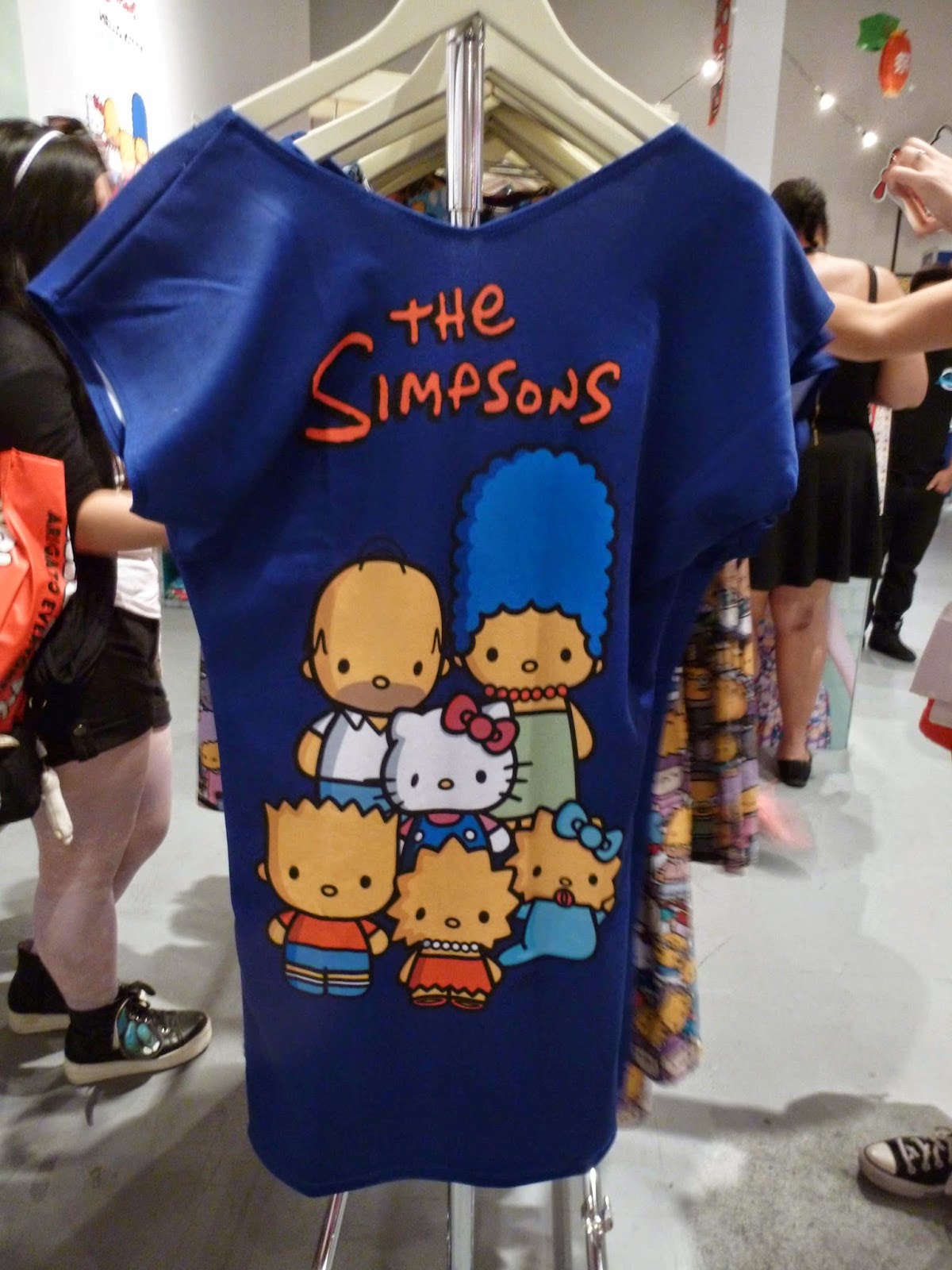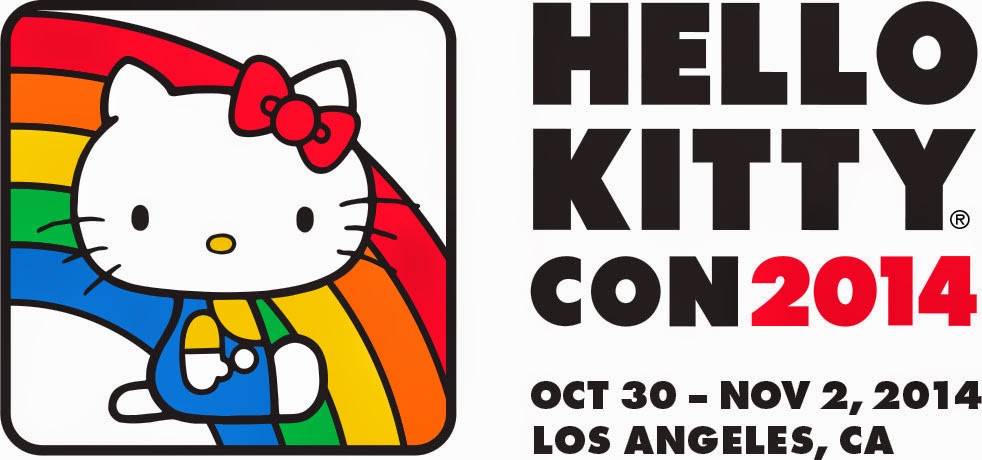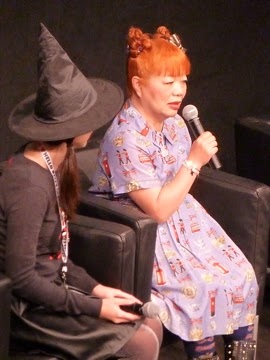new posts in all blogs
Viewing Blog: The Fourth Musketeer, Most Recent at Top
Results 1 - 25 of 435

reviews and more about historical fiction for children and teens
Statistics for The Fourth Musketeer
Number of Readers that added this blog to their MyJacketFlap: 2
It's March again, and that means that Lisa Taylor of
Shelf-employed and I are once again co-curating
Kidlit Celebrates Women's History Month, a celebration of books for young people which celebrate notable women. Despite the progress that has been made, schools still spend comparatively little time on women throughout history; fortunately many books have been published for young people of all ages on a range of fascinating figures which can be used by teachers to supplement the curriculum or by parents at home. I hope you will check out this year's blog contributors, who include everyone from African-American ballerina Misty Copeland to award-winning nonfiction writer Sue Macy. You can "follow" the blog, subscribe by e-mail, and also follow the posts on Facebook, Twitter, or Pinterest, if you prefer! A complete list of this year's contributors is available on the blog as well.
If you're in the Los Angeles area, I believe you can still order tickets for the
35th anniversary celebration of the National Women's History Project, which will take place on Saturday, March 28 at the Autry Museum and offers the chance to meet the 2015 honorees. It's a terrific opportunity to celebrate women's history with others.
I am honored to welcome to my blog today author Jennifer Elvgren, the author of The Whispering Town, winner of the Sydney Taylor Honor Award in the Older Readers category. The Sydney Taylor awards are given out annually by the Jewish Libraries Association for new books for children and teens that "exemplify the highest literary standards while authentically portraying the Jewish experience." The Whispering Town tells the story of an ordinary heroine, a young girl named Anett, who together with others from her Danish village community, help hide a Jewish family until they can escape from the Nazis. The story is illustrated in graphic novel style by Italian illustrator Fabio Santomauro. Jennifer kindly answered some questions for me as part of the Sydney Taylor Award winners blog tour. The complete blog tour schedule, which runs from February 8 to the 13th, can be found here.  |
| Author Jennifer Elvgren |
Q: The Danish people's heroic efforts to save "their" Jews are one of the few "feel-good" stories from the Holocaust. What inspired you to create a picture book on this topic?
A: Somewhere around late elementary, early middle school, my grandmother gave me her copy of The Hiding Place by Corrie ten Boom, and my mother gave me a copy of The Diary of a Young Girl by Anne Frank. From a young age, I pondered the bravery of those hidden and the bravery of those who protected the hidden. I carried this interest in Holocaust literature as I grew and started my writing career as a print journalist. When I began writing solely for elementary children after my second child was born, I wondered if there was a way to tell a Holocaust story to a younger set of readers. Around 2009, I read Ellen Levine’s nonfiction book Darkness over Denmark: The Danish Resistance and the Rescue of the Jews. One Jewish boy recollected his father trying to find the Gilleleje harbor on a moonless night and villagers stood in doorways giving him directions. As I read this, I could see the storyboard in my mind – Anett and her parents hiding a Jewish family and enlisting the village to whisper them to safety.
Q: Could you comment on the unique challenges of writing a book aimed at young children on the Holocaust?
A: For the youngest readers, I wanted to portray danger, not horror. I intended this book to be the start of a lifelong discussion of the Holocaust, focusing initially on kindness and bravery. In early drafts of The Whispering Town, I went too far the other way and watered down Anett’s character. I never had her come face-to-face with Nazi soldiers. After a meeting with my critique group, there was consensus that Anett must face the soldiers. By not doing so, she would have been robbed of her greatest chance to be brave. Now I believe that was the best decision for her. Anett was able to dig down deep, think fast on her feet and face her greatest fear.
Q: What kind of research did you do for this story? Is Anett based on a real girl?
A: In this story, Anett is a fictional character, and I researched the occupation of Denmark and the Danish Resistance, which smuggled almost all of the Danish Jews out of Denmark.
Briefly, on April 9, 1940, at 4:14 a.m. Germany began the invasion of Denmark by land, sea and air. The invasion lasted six hours, which was the shortest operation in WWII. The Danes knew the attack was coming but were denied permission to fight, as the Danish government did not want to provoke the Germans. Denmark cooperated, but did not collaborate. As a result, King Christian X stayed on the throne and continued to live at the palace in Copenhagen. From 1940 to October 1943 resistance to the occupation mostly took the form of bursts of national pride like when King Christian X took his daily ride through the Copenhagen streets to meet throngs of flag-waving Danes, a few scattered acts of sabotage, strikes and a slow down of the workforce.
During the summer of 1943 Danes had grown weary of the occupation and their acts of sabotage became more violent including riots in Copenhagen. In August 1943, the Germans declared a State of Emergency and by September, Hitler approved the deportation of Danish Jews to death camps.
Danes were horrified. People from all walks of Danish life – clergy, government workers, storeowners, farmers, fisherman, teachers, police and the coast guard – protected Jews. The Danes hid Jews in barns, cellars, hospitals, summerhouses, churches and warehouses. They loaned boats and gave money to hire boats to smuggle Jews out of the country to neutral Sweden. The Danes also protected Jews’ houses and belongings until after the war.
Q: The Whispering Town shows young children the heroism in ordinary people, as opposed to the superheroes that delight so many children. In this case, the heroes are not Spiderman or Batman, but a small girl, a baker, a librarian, and a farmer. How did you happen to choose these three professions to represent the Danish people? (Of course, as a librarian, I am delighted by the choice of a librarian!)
A: In times of crises, and anytime really, food and words bring comfort, healing and love. When my friends are facing illness or sadness, I deliver homemade food and/or books to their doorsteps. With Carl and his mama so frightened in her cellar, it seemed natural for Anett to bring them her favorite food and books, to feed their bodies and souls.
Q: As an author, how did you feel about the illustrations Fabio Santomauro drew for your text? With their graphic novel feel, they are quite different from the illustrations in most of the picture books about the Holocaust.

Jennifer, thanks so much for participating in the Sydney Taylor 2015 blog tour! Please check out interviews with other winners throughout this week (see blog tour schedule below).
SUNDAY, FEBRUARY 8, 2015Una La Marche, author of Like No OtherSydney Taylor Honor Award winner in the Teen Readers CategoryAt BildungsromanMONDAY, FEBRUARY 9, 2015Lizzie Skurnick, publisher of Isabel's War by Lila PerlSydney Taylor Honor Award winner in the Teen Readers CategoryAt Pen & ProseAuthor Jennifer Elvgren and illustrator Fabio Santomauro, creators ofThe Whispering TownSydney Taylor Honor Award winner in the Older Readers CategoryAt The Fourth MusketeerTUESDAY, FEBRUARY 10, 2015Loic Dauvillier, Mark Lizano and Greg Salsedo, creators of Hidden: A Child's Story of the HolocaustSydney Taylor Book Award winner in the Older Readers CategoryAt The Interlace PlaceAuthor Jim Aylesworth and illustrator Barbara McClintock, creators ofMy Grandfather's CoatSydney Taylor Book Award winner in the Younger Readers CategoryAt Sandra Bornstein's BlogWEDNESDAY, FEBRUARY 11, 2015Author Barbara Krasner and illustrator Kelsey Garrity-Riley, creators ofGoldie Takes a StandSydney Taylor Honor Award winner in the Younger Readers CategoryAt Write Kids' BooksDonna Jo Napoli, author of StormSydney Taylor Book Award winner in the Teen Readers CategoryAt Jewish Books for KidsTHURSDAY, FEBRUARY 12, 2015Donna Gephart, author of Death by Toilet PaperSydney Taylor Honor Award winner in the Older Readers CategoryAt Monkey PoopAuthor Jacqueline Jules and illustrator Durga Yael Bernhard, creators of Never Say a Mean Word AgainSydney Taylor Honor Award winner in the Younger Readers CategoryAt Ann Koffsky's BlogFRIDAY, FEBRUARY 13, 2015Blog Tour Wrap-Up with All Authors and IllustratorsAt The Whole Megillah
Recommended for ages 5 and up.This inspiring picture book by author
Laurie Ann Thompson tells the moving true story of Emmanuel Ofosu Yeboah, a young man born with a severe disability in rural Ghana who nonetheless bicycled across the entire country, raising awareness for disabled people throughout Africa and around the world.
The book opens with a touching tableau--a beautiful baby boy has been born, but with only one strong leg. We can see the despair in the father's posture and the fear in the mother's eyes as she looks at the baby's father. Disabled children in Ghana were not only considered worthless-they were considered a curse, and the baby's father soon abandons the family. The mother's hope is seen in her naming the baby "Emmanuel," which means "God is with us."
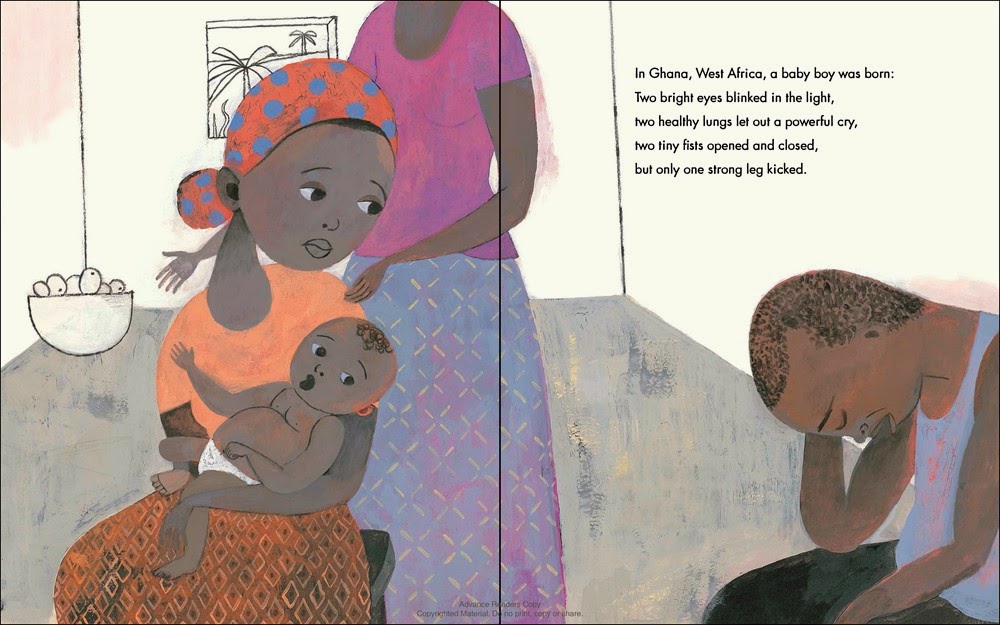
Emmanuel's mother refuses to allow her child to become a beggar, as was the custom for disabled people in Ghana; instead she helps him to become self-sufficient, hopping to school, two miles each way. When his classmates scorned him, he saves money to buy something no one in the school had--a real soccer ball, and earns their respect by learning to play on just one leg. When his mother falls ill, Emmanuel moves to the big city to earn money to support his family. Sadly, his mother dies, but he honors her memory by dreaming up a way to show that disabled people could do anything--a bike ride around his country--nearly 400 miles. Support for what others deemed an impossible project came all the way from America, along with the equipment he needed. We see Emmanuel riding across the country, surrounded people cheering, including disabled countrymen. Thompson concludes this inspiring story as follows: "He completed his astounding journey...in just ten days. But Emmanuel's success goes even further than that. He proved that one leg is enough to do great things--and one person is enough to change the world."
In her first picture book, author Laurie Ann Thompson admirably succeeds in her mission of teaching children about social justice issues, a campaign she began in her young adult nonfiction book,
Be a Changemaker, a how-to book for young social entrepreneurs
. Thompson's tale is enhanced with mixed media illustrations by award-winning children's illustrator
Sean Qualls (
Before John Was a Jazz Giant and
Skit-Scat Raggedy Cat among others). He uses a "primitive" style of illustration, relying on collage and paint to convey the emotion of Emmanuel's story.
An author's note explains that Emmanuel has continued to achieve great things, competing in major athletic events, carrying the Olympic torch, and starring in a documentary about his life,
Emmanuel's Gift, which I will be putting on my Netflix queue. He continues to work to help disabled people, particularly in Ghana, realize their full potential.
This is a wonderful book to share with elementary school children; for older children it can be paired with viewing the documentary.
Release date: February 10, 2015
Recommended for ages 10 and up.
Jane Eyre meets Goldilocks and the Three Bears in this enchanting tale of Ursula, an impoverished yet well-brought-up young governess hired to take care of adorable young Theodore Vaughn in a creepy, huge manor house in which portraits follow you with their eyes, strange unseen footsteps follow you down the hall, and objects disappear from rooms without a trace. There's mystery, adventure, small town politics, and even romance. Sound familiar? But in this book our main characters are all....well, bears. Filled with tropes from gothic novels, this book draws you into its enchanted world and is hard to put down. It is sure to please tweens and even teens who enjoy fairy-tale mashups, whether TV series such as Once Upon a Time and Grimm or books by Shannon Hale, Adam Gidwitz, Michael Buckley, and others.
Our story is set in the Enchanted Forest, populated not only by characters from the Goldilocks tale but also characters from other beloved stories and nursery rhymes such as The Three Pigs, the Old Woman Who Lived in the Shoe, and the Bremen Street Musicians. These talking animals live in peace with their human counterparts. But when a mute, filthy, starving little girl with golden hair is taken in by the kindly bear family, prejudice against the talking animals from the human community comes to the forefront. Will Goldilocks, who becomes a beloved foster child, be able to stay with her new bear family? And what will happen to the kindly governess, Ursula, who has fallen in love with Mr. Bentley, another member of the Vaughn family's staff? The novel is full of bears who know Latin, awkward but well meaning ministers, seemingly menacing nurses; Coville does a marvelous job capturing the formal vocabulary and images of the 19th century period in which the story seems to be set, a time in which even young proper bears must wear corsets and not spend time alone in the company of a young male bear. If you've read Jane Austen and other 19th century novelists these touches are especially endearing.
Note: Review copy received through Amazon Vine.
Recommended for ages 4-8.
Award-winning author
Kathy Appelt tackles the tricky subject of stepfamilies in her newest picture book,
When Otis Courted Mama. Less than half of US families live in traditional households (i.e. two heterosexual parents in their first marriage), according to a
2014 Pew Research study. Yet most of our picture books still seem to reflect an "ideal family" that's just not the reality for most kids. Books such as
When Otis Courted Mama fill a gap for many children who need books that address their own family situations.
Appelt creates an appealing protagonist in the coyote pup Cardell. He has a "most wonderful life" for a young coyote; he lives with his "perfectly good" daddy and his step-mother and step-brother part of the time, and with his "perfectly good mama" the rest of the time at the opposite end of the desert (who knew coyote families were so complicated?) In general, Cardell has his mama all to himself, and he likes it that way. He feels loved "through and through" by both his parents, and that's the way it should be.
Complications to young Cardell's life ensue when Mama's neighbor Otis comes courting, carrying ocotillo flowers in one paw and a bag of cactus candies in the other. It's clear that Mama's been dating for a while, and some of her prior suitors are comically described in the text and illustrations, but none of them was any real threat to Cardell's close ties with Mama. Otis is the first coyote caller that Mama doesn't send packing. Cardell isn't too happy about this, but his growling at Otis doesn't seem to do any good. In the end, Otis wins Cardell over and the new coyote family lives happily ever after, sticker burs and sand fleas aside.
This book deals sensitively with the many complicated feelings of jealousy that ensue for a child when a parent begins a new relationship. Cardell learns that although Otis isn't good at the same things as his own daddy, he has other qualities to offer, and in the end he still has a "perfectly good daddy and a perfectly good mama...but now Cardell also had someone else: Otis!" The casting of coyotes instead of humans in this picture book gives what could be a serious subject a playful tone. The coyotes are more human than animal, however, as they walk on two legs, and engage in decidedly human activities such as making flapjacks, playing instruments, reading books, dancing, and even painting pictures (Cardell's Mama is an accomplished artist). Yet they also engage in coyote behavior such as howling at the moon, and in addition to flapjacks, Cardell's diet includes more typical coyote-like fare such as rats and chuckwallas. Illustrator Jill McElmurry creates very large-eyed coyotes that look more cute than predator-like, and the coyotes are depicted wearing natty accessories like hats, scarves, and flowers in their fur. There's lots of local Southwest color in the story, both in the text and in Jill McElmurry's whimsical images, which make use of a traditional Southwestern palette, and the Southwestern landscape of mesas and cactus reinforces the setting for young readers.
For more on Cardell, Otis, Mama, and Kathi Appelt, check out the other blog tour stops:
date | blog | blog URL |
Mon, Jan 5 | 5 Minutes for Books | |
Tues, Jan 6 | Cracking the Cover | |
Wed, Jan 7 | Sharpread | |
Thurs, Jan 8 | Unleashing Readers | |
Fri, Jan 9 | Once Upon a Story | |
Sat, Jan 10 | Booking Mama | |
Mon, Jan 12 | Geo Librarian | |
Tues, Jan 13 | The Late Bloomer's Book Blog AND NC Teacher Stuff | |
Wed, Jan 14 | Teach Mentor Texts | |
Thurs, Jan 15 | Kid Lit Frenzy | |
Fri, Jan 16 | The Fourth Musketeer | |
Giveaway!
One lucky winner will receive a copy of WHEN OTIS COURTED MAMA by Kathi Appelt, illustrated by Jill McElmurry (U.S. addresses only)
Over the last month or so, I have not had much time for my blog since I have been very busy reading over 100 titles as a first-stage judge in the Nonfiction for Early and Middle Grades category of the Cybils awards. Growing up in the 1960's and 1970's, when there was a lack of attractive nonfiction books for kids, I found a special delight in reading so many fabulous nonfiction books for kids on every conceivable topic, from history, biography, astronomy, animals, archaeology, and much much more. There is a book out there for every young reader, and for many it might be one of these excellent nonfiction titles. A list of the seven titles picked as finalists follows, along with blurbs by the committee members:
by Russell Freedman
Clarion Books
Nominated by: Jenna G
While Ellis Island is frequently written about in literature for young people, few Americans are familiar with its West Coast equivalent, Angel Island, off the California coast, which processed about one million immigrants from Japan, China, and Korea at the beginning of the 20th century. Using original source documents, including memoirs, diaries, letters, and “wall poems” written directly on the walls of the facility, master nonfiction writer Russell Freedman brings the moving story of this little-known facility to life. The book is abundantly illustrated with archival photographs and includes extensive back matter.
by Sy Montgomery
Houghton Mifflin Harcourt
This book chronicles the efforts of Laurie Marker and the Cheetah Conservation Fund to save the endangered cheetahs of Namibia through unique collaborations with the local farmers. Like most Scientists in the Field titles, it includes the story of the main scientist’s life, involvement and viewpoints of locals, and stunning photographs. This is a perfect blend of inspiration and science, encouraging kids to dig deeper and think about a popular topic. A great book for strong middle-grade readers to enjoy on their own or to read together as a family or class.
by Melissa Stewart
Charlesbridge
This unique look at a bird’s most obvious characteristic, its feathers, compares the many different uses of feathers to familiar items like a blanket and an umbrella. The text is layered with simple, declarative sentences and more complex factual captions and statements. Stunning artwork creates a scrapbook effect out of illustrations, with a skillful use of shadows to create a three-dimensional effect. This lovely and useful book will catch the interest of preschool through early elementary students who will pore over the art, be drawn into the text, and possibly inspired to start their own nature notebooks.
by Loree Griffin Burns
Millbrook Press
The Very Hungry Caterpillar gets a literary partner for older children in Handle With Care, which takes readers on a visual tour of a butterfly farm in Costa Rica to further explore the miracle of metamorphosis. Accurate but restrained text complements the crisp photos popping with color. Sometimes the photos are a single, detail-revealing close-up, while others use fascinating multiples & patterns: caterpillars in a bucket, pupae sorted into piles for shipping or lined up in neat rows. Generous use of white space keeps the focus trained on the miracle – the life cycle of butterflies. More than a simple documentary of the process, Handle With Care sets the understanding of metamorphosis in the larger context of our living, global ecosystem. It introduces the more challenging concept of the values and beliefs that drive the acquisition and application of scientific knowledge. Useful across several age levels, opportunities abound to enrich school curriculum in science as well as social studies. The title skillfully spotlights the larger message that, when handled with care, the earth and its inhabitants can flourish together.
by Duncan Tonatiuh
Harry N Abrams
Most school-aged children can tell you about Ruby Bridges. Far fewer, however, maybe almost none, know about Sylvia Mendez, and yet it was Mendez and her family who actually paved the way for desegregation in California in 1947, seven years before Brown vs. the Board of Education and over a decade before Ruby Bridges attended school in New Orleans. Duncan Tontiuh’s picture book, Separate is Never Equal, chronicles the story of Mendez vs. Westminster in a way that is understandable to very young children, and yet appealing to young adults. Tontiuh was born in Mexico City, and his desire “to create images that honor the past, but that address contemporary issues that affect people of Mexican origin on both sides of the border, ” is clearly reflected in his style, which draws heavily on the ancient Mixtec Indian tribe. End matter includes a note from the author, photographs of Sylvia, her parents, and the schools she attended, a glossary, a bibliography, and an index. A book that should be read in every classroom!
by Sandra Markle
Millbrook Press
Publisher/ Author Submission
Bats might seem a bit frightening, but they actually do all of us a huge favor. They eat about half their bodyweight in insects – roughly the equivalent of a thousand mosquitoes – each night! This means they help limit the spread of disease and protect crops. Little brown bats were once one of the most common bat species in North America, but a few years ago scientists noticed that the bats were behaving oddly and dying out in huge numbers each winter, struck down by a mystery killer.
Markle walks us carefully though the mystery, first by explaining the lifestyle of little brown bats and the important role they play in the ecosystem. Next she introduces us to a variety of scientists from different disciplines, all of whom are working together to solve the mystery and save the bats. With attractive layouts and amazing photographs, The Case of the Vanishing Little Brown Bats neatly lays out the steps that scientists take to solve the problem – developing a set of hypotheses to investigate, collecting data in order to test each one, zeroing in on the culprit and finally proposing a range of possible solutions. This book is a wonderful introduction to problem solving for middle grade students, animal lovers, and budding scientists.
by Rebecca L. Johnson
Millbrook Press
Publisher/ Author Submission
If a good defense is the best offense, then When Lunch Fights Back: Wickedly Clever Animal Defenses by Rebecca L. Johnson shows just how offensively awesome some animals and plants can be when it comes to protecting themselves from predators. The photography, which utilizes a combination of well-timed traditional and underwater photography, x-ray technology, and visuals captured with a scanning electron microscope, amplifies the reader’s understanding of how each animal employs its unique defenses. When Lunch Fights Back is an incredible highlights reel of gross facts about the techniques animals use to survive to fight another day. Johnson has created a compilation that will be stalked by kid-predators looking to devour the facts inside and fortunately, this book will not fight back. When Lunch Fights Back is well documented with source notes, photo acknowledgements, a selected bibliography, and a number of sources to continue to explore the topic further.
It's a special pleasure to welcome to the Fourth Musketeer author/illustrator David Ezra Stein. David is the creator of many award-winning picture books, including Interrupting Chicken, which was awarded a Caldecott Honor, and Dinosaur Kisses. His books are great read-alouds, and are favorites of librarians, teachers, parents, and yes, kids.
He has kindly agreed to answer a few questions about his very funny new picture book, I'm My Own Dog. In a role reversal that will tickle all dog lovers, this dog has no need of a human owner. He can perfectly well take care of himself (except for that one little spot he can't scratch). But what will happen when he lets one of those cute humans follow him home? Kids and adults alike will love the reversal of roles in Stein's newest book.
Q: David, my miniature poodle Buddy would love your new book--if he could read. He definitely thinks he's in charge of the house and will even carry his own leash and throw toys to himself in play and then run and fetch them. Was there a particular dog that inspired you to create the character in I'm My Own Dog?
 |
| my dog, Buddy |
A: Hi Margo! Maybe he can read, but doesn’t want to let on. Even if he doesn’t read English, I’m hoping this book will be translated to Doggish sometime soon. Admittedly, it’s hard to find a translator…. “Woof! Wauf! Wooooah! Wuf. Rrrrrr?” Sorry for the interruption; that was just me asking if there are any dog translators out there. I only speak a little, broken Doggish.
I was not inspired by any one dog, but by my inner dog, I suppose, who wants to be his own master. To be able to choose how he responds to the world, and not be lead around by a leash of fear or knee-jerk reaction. That is a kind of mastery. That is a dog who walks himself.
 |
| some examples of Stein's humor and artwork |
Q: Who are some of your favorite fictional dogs, either in children's or adult literature?
A: Harry the Dirty Dog.
Q: Could you discuss a bit using animals or monsters as protagonists in children's books instead of actual children? I've always wondered if this decision was made in order to avoid having to choose a specific race if children were used, or is it really just because it's much more fun to draw chickens and dogs than kids?
A: Sure. I don’t know that there’s only one answer to this, but it does seem to me an animal or monster or whatever non-human character we employ in literature, is used to give a higher degree of universality. Kids tend to be open to animals in a way that they are not open to people.
It is perhaps easier to achieve a timeless quality using non-humans, because you can circumvent the trappings of fashion, technology, etc.
And yes, I do think it’s effective to use animals when it comes to race and even gender, in that it helps focus on the subject matter, and I think it is more relatable for all children.
Additionally, although we live mainly in cities, there is still an archetypal wilderness inside each of us, populated by wolves, bears, rabbits, owls, snakes, and such. Whether this stems from Fairytales, or Aesop’s Fables, or much deeper times when we ourselves lived in the woods, I don’t know.
Lastly, from an illustration standpoint, it is more fun to draw creatures or animals. I am not that into drawing kids, for some reason. Animals and monsters and such can be designed to an extent that allows for a lot more leeway.
David, thanks so much for visiting The Fourth Musketeer! I look forward to reading I'm My Own Dog in one of my library storytimes soon!
In addition to his website, you can find David Ezra Stein on Facebook. Here's the schedule for the complete blog tour: 11/3/2014 Smart Books for Smart Kids11/4/2014 Read Now, Sleep Later11/5/2014 Cracking the Cover11/6/2014 Elizabeth Dulemba's blog11/7/2014 The Fourth Musketeer11/8/2014 Picture Book Palooza11/9/2014 Randomly Reading11/10/2014 Children's Corner11/11/2014 Flowering Minds11/12/2014 Teach Mentor Texts11/13/2014 KidLit Frenzy11/14/2014 Literacy Toolbox
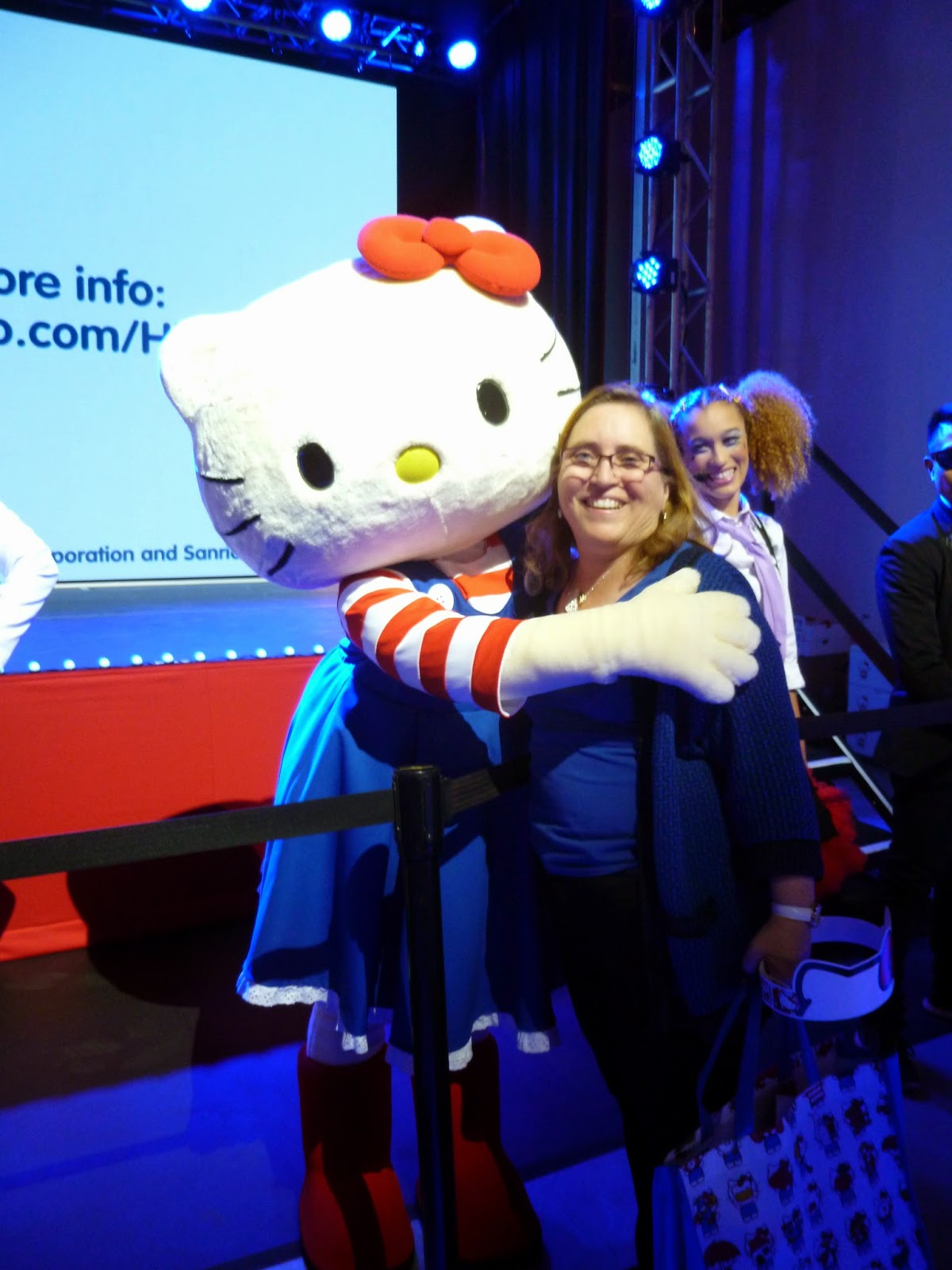 |
| a hug from the famous Kitty |
When I started blogging a number of years back, I didn't know there might be special perks associated with being a blogger. Recently I was thrilled that I was able to snag a special invitation to the
Hello Kitty Con press preview and VIP party because of my blog! I've lived in Los Angeles nearly all my life, but I'm not exactly a regular at red carpet events. This was my first time attending such a large gathering as "press"--not only did we get to see the convention's exhibits without the massive sold-out crowds that were there during the convention, we got a fabulous swag bag filled with Hello Kitty themed freebies (many of which you had to stand in line for FIVE or SIX hours during the convention to buy at a special store for convention attendees only!)
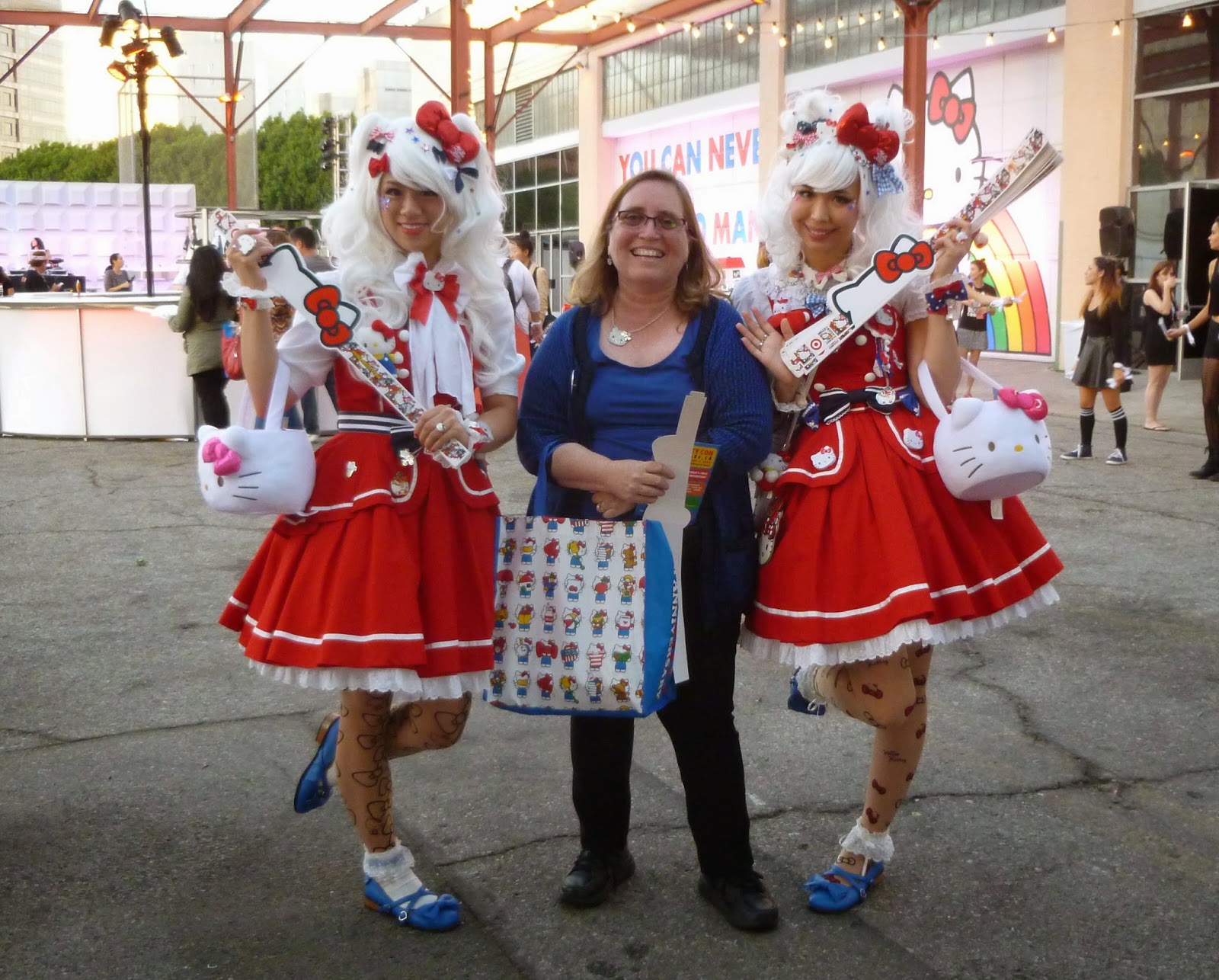 |
| with my swag bag and several Hello Kitty girls |
I also attended a glamorous party on-site, complete with open bar (Hello Kitty-themed grown-up drinks, of course), adorable Hello Kitty food, and of course music as well.
 |
| cupcakes featuring Hello Kitty and her iconic bow |
This was the first-ever Hello Kitty convention, which lasted for four days in Los Angeles and completely sold out the 25,000 tickets available. Organized by
Sanrio in celebration of Hello Kitty's 40th anniversary, fans came from all over the country to attend (and perhaps all over the world, although I didn't talk to any from abroad). Like Comic-Con, Star Wars cons, and other such events, the four days were filled with exhibits, expert panels, workshops, costume contests, art classes, and of course, plenty of shopping opportunities. The press preview had just a few hundred guests, so it was great to be able to see all the exhibits without the huge crowds that were there when I came back with my regular ticket on Friday. The convention was held in the Geffen Contemporary, a large, warehouse like space in Little Tokyo that is part of Los Angeles'
Museum of Contemporary Art (MOCA). It is conveniently next door to the
Japanese-American National Museum, which is also hosting a special
Hello Kitty exhibit (Hello! Exploring the Supercute world of Hello Kitty) which runs until the end of April. The museum (and of course its store) was open to all convention attendees free of charge.
 |
| Japanese-American National Museum |
Sanrio was founded 55 years ago as a company to promote friendship through small gifts, and the first Hello Kitty product produced cost less than the equivalent of $1 (in yen, of course). The company was known for small inexpensive products such as pencils, stickers, and small toys, although now Sanrio licenses with celebrity designers such as Tarina Tarentino (
see my last post for more on that topic) for more upscale products as well. As one would expect, the exhibits were full of Hello Kitty products on display, including the original first coin purse, now kept in a vault in Japan but sent to the convention for exhibit.
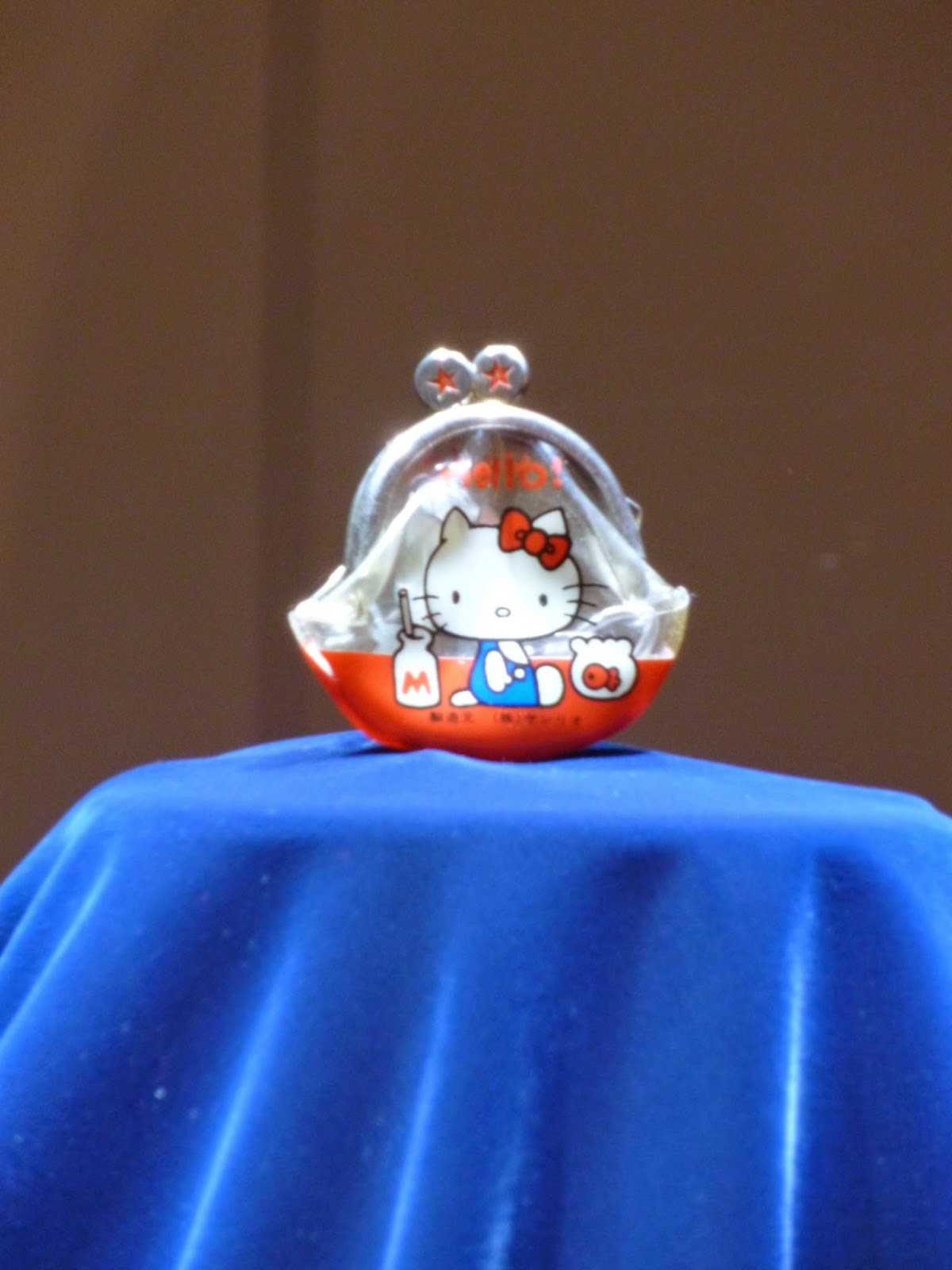 |
| original Hello Kitty coin purse |
It was displayed in its own darkened room, with a beautiful display case, much as one might see the Crown Jewels or the Hope Diamond! There was also a huge reproduction of the original coin purse, set up for photos ops.
In a Hello Kitty house, each room was filled with Hello Kitty merchandise from over the years. I particularly admired the office.
 |
| Hello Kitty's office |
The highlight of the convention for me was the pop-up designer shops, set up as a Japanese marketplace, complete with Zen garden.
These pop-up shops included special items produced for the convention by Sanrio licensees such as Sephora (which was doing free makeovers), Dr. Dre (who knew he liked Hello Kitty?) Dylan's Candy Bar, Spam, and a variety of toy and clothing manufacturers, including Japan LA, a fashion designer who featured special SimpsonsXHello Kitty clothing.
There were lots of fun photo ops with very kawaii (Japanese for cute) Lolita girls decked out in Hello Kitty gear, and even a chance to have a photo with the Kitty herself. Art was also a big part of the displays--there were lots of Hello Kitty inspired paintings, ceramics, and even a tattoo studio tattoo where you could get free tattoos. Sanrio artists were even signing free personalized drawings.
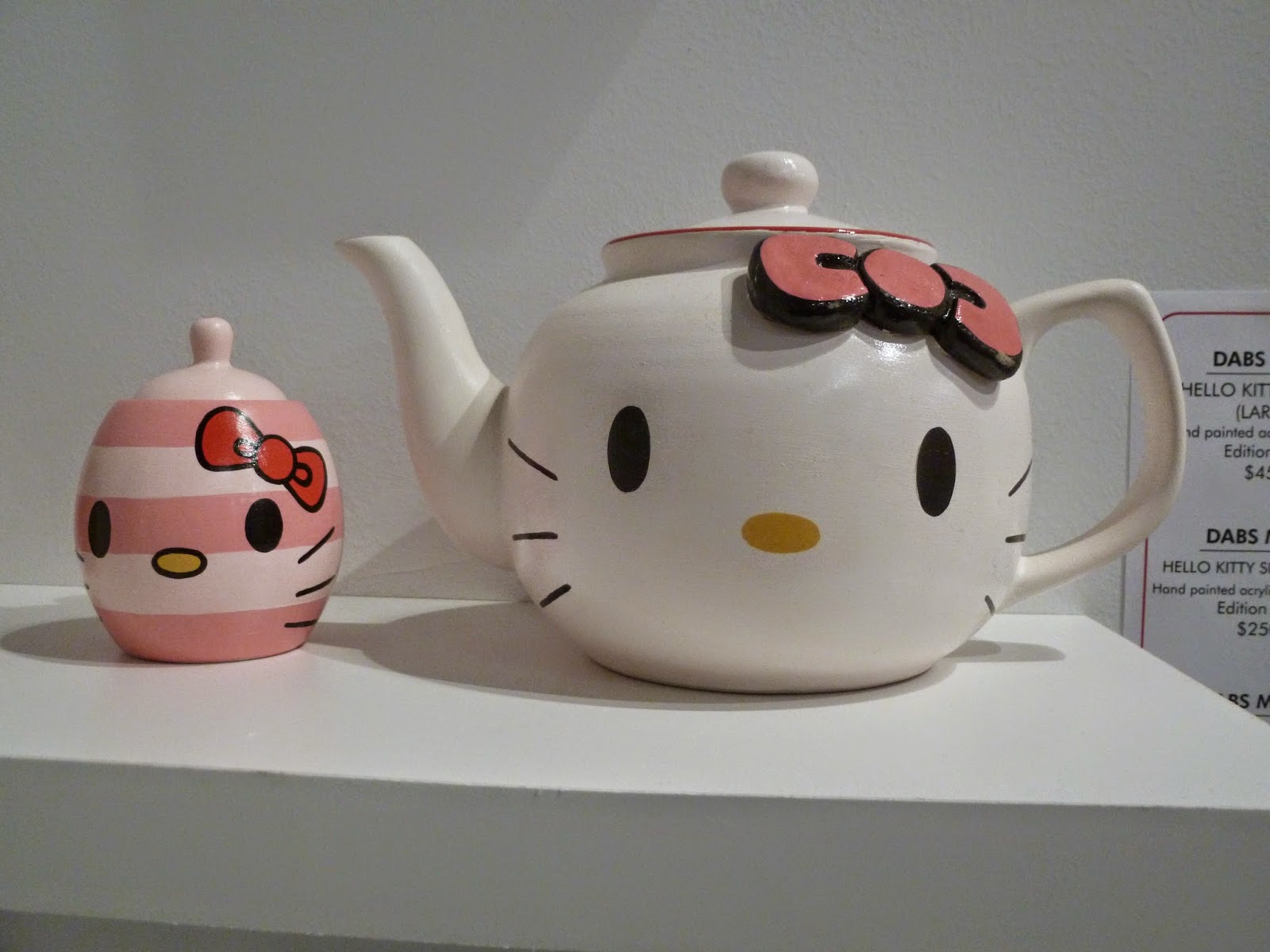
I returned on Friday for the actual convention, and was exceedingly grateful I had been there for the press preview since during the regular convention the place was packed with happy Hello Kitty fans of all ages! Lots of fun but lots of lines. Luckily I had had a chance to peruse all the exhibits when I was there Wednesday night. I was impressed by the very well-behaved smallest fans--I didn't overhear any whining from the kids about lines or anything else. Kids and grown-ups could participate in special art classes to learn to draw Hello Kitty (not as easy as she looks), decorate a Hello Kitty pumpkin, and make Hello Kitty sand art and coloring sheets, among other activities. There was even an arcade where you could play games for free and win Hello Kitty prizes, all lots of fun for the kids. Hello Kitty fans attending ranged from babies in strollers to an elderly Japanese couple I noticed, who must have been in their mid-80's at least. I even met a group of 3 generations of Hello Kitty fans--a mom, grandma, and daughter, all decked out in costumes.
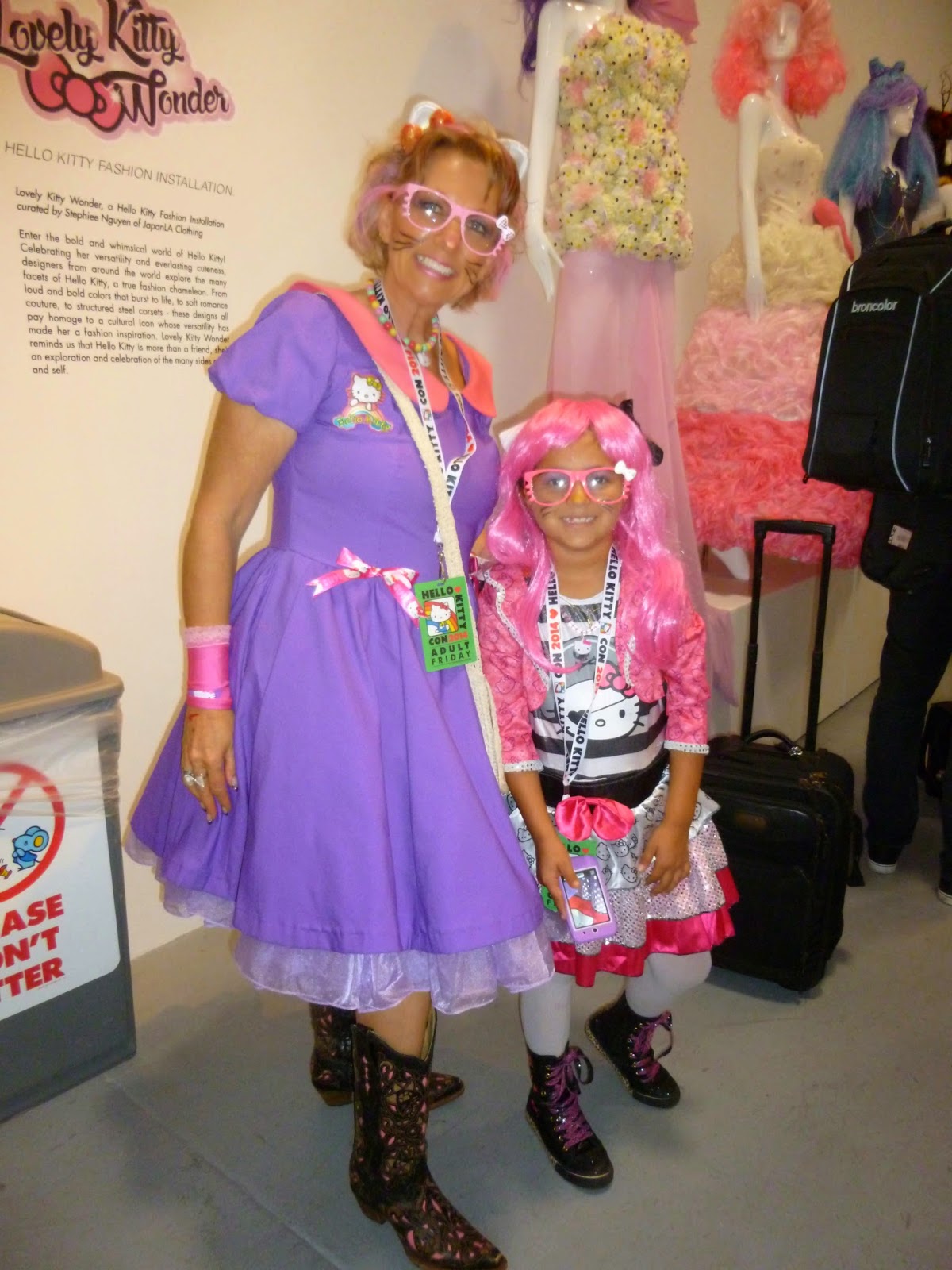 |
| grandma and granddaughter Hello Kitty fans |
On Friday I was able to attend a highly coveted workshop (these all sold out well in advance) with jewelry designer
Onch Movement. We were all able to make a special Hello Kitty necklace that was designed by Onch and available only to those who participated in the workshop--very exclusive! Onch himself was adorable and came around to help everyone and pose for pictures. Luckily I was sitting next to a very nice lady who had lots of jewelry making experience because I needed a lot of help working with those tiny rings.
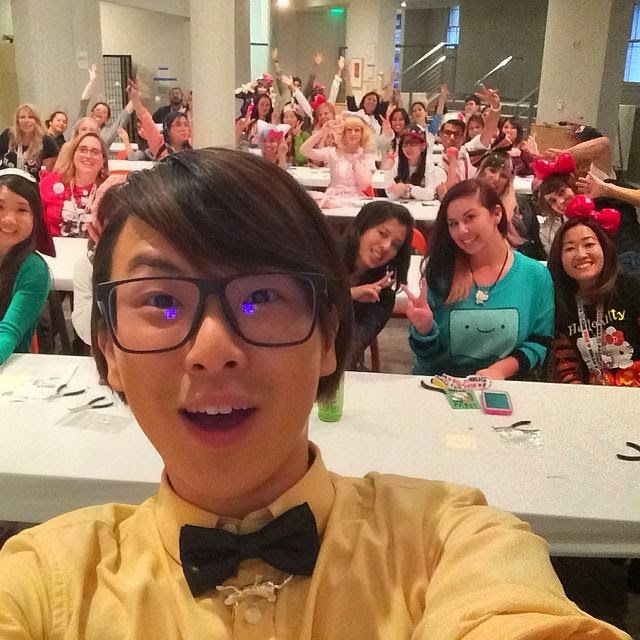 |
| Onch and there I am in the second row with my red Hello Kitty shirt! |
When I left the convention I was on a definite Hello Kitty high with all the adorableness of Sanrio and the nice people I had met. Here's hoping the Hello Kitty con will become an annual event!
For more on Hello Kitty and reading, I will be doing a guest post on the
ALSC blog later this month.
If you're a real Hello Kitty fan, you can check out my
on-line photo album at Flickr--lots more really fun pictures. As you scroll over the pictures, you can read my captions as well.
Off my usual blogging subjects, I am going to share some details of the first ever Hello Kitty con!
I was so fortunate to be able to attend the sold-out con going on in Los Angeles this weekend. I love all things "kawaii" (Japanese for cute) and signed up for the convention as soon as I read about it on Sanrio's website. I attended the press preview and VIP party (!) on Wednesday night (more on that to follow) and then went to the Con as a regular participant on Friday. My favorite experience was an all-star panel on Friday with
Yuko Yamaguchi, Sanrio Tokyo’s head Hello Kitty designer, and fashion jewelry designer to the stars
Tarina Tarantino.
The two first met ten years ago at the time of Hello Kitty’s 30
thanniversary, when Tarina designed her first Hello Kitty collection. Tarina, looking suitably kawaii (cute) with her signature bright pink hair, told us that she discovered Hello Kitty in the late 1970’s when her grandparents brought her some small gifts from Japan decorated with the very simple but adorable cat. Soon after, Hello Kitty went on sale in the US and Tarina reminisced about collecting Hello Kitty from a Bullocks (a now defunct department store) display when she was a girl in Los Angeles. “I have to pinch myself” Tarina said, when she thinks that now she designs jewelry collections featuring the iconic figure. She called Yuko her Japanese soul-sister and says she wants to play dress-up in Yuko’s closet some day when she is in Tokyo!
I furiously took notes during the panel so that I could share some of the fascinating accounts. Here's some of the highlights...
Tarina: Could you tell us about the back story of Hello Kitty?
Yuko: When I first met Hello Kitty in 1980, it was two years after I started working for Sanrio. At that time Hello Kitty was not the most popular Sanrio character. Even I didn’t think of Hello Kitty as a valuable asset. At that time, Little Twin Stars was the most popular Sanrio character and dominated their sales. Sanrio’s founder was concerned that Hello Kitty’s popularity was not growing, and was looking for a designer to take on the task of building her brand. But no designer wants to be assigned to a character that’s not popular. The Sanrio founder asked all the designers to present new designs for Hello Kitty. I thought that the key to re-invent Hello Kitty was not the visual, but creating different stories. According to Sanrio’s own newsletter, Hello Kitty dreamed of becoming a professional pianist, but you never saw her playing the piano, so that’s what I drew. As a child I took piano lessons and had a grand piano at my home, so I imagined Hello Kitty had a grand piano.
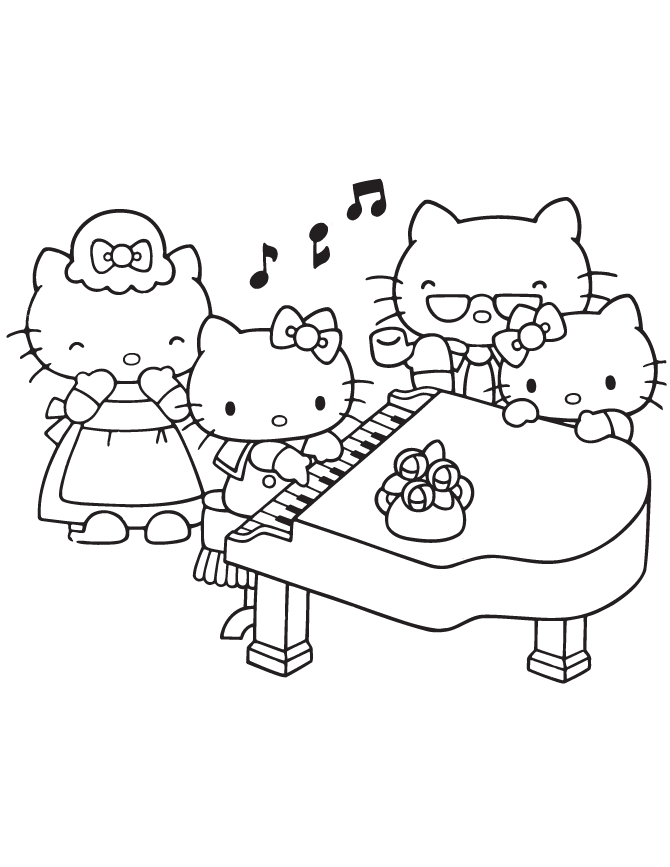
I also imagined that Hello Kitty’s mom was a pianist, and her father must have a well-paying job to be able to afford that grand piano. I presented the story of Hello Kitty and her family and then was told that I should be the Hello Kitty designer—not because I was the best artist but because I had the imagination and was willing to present my ideas, that’s why I was chosen.
There was a lot of pressure to develop a character that wasn’t popular. I was talking to Hello Kitty every day. When did Hello Kitty talk back? I will never forget in the fall of 1985 she spoke back to me for the first time. After five years she because the #1 character at Sanrio. This is what Hello Kitty told me after five years: “We did it!” At that time I decided to take it a notch, for her to be the #1 character in Japan. But Hello Kitty didn’t say anything. In the spring of 1997 many years later she became the #1 brand in Japan.
Hello Kitty has become another form of myself. At that time I wasn’t sure if I was Hello Kitty or Hello Kitty was me. I made a promise to make her the #1 character in the world!
Tarina: On the question that has consumed portions of the Internet lately, as to whether Hello Kitty is a cat or a girl…
Yuko: Since I met Hello Kitty, I thought of her as Hello Kitty. She’s not a cat and she’s not a human. I just want Hello Kitty to be a role model and the question as to whether she’s a cat or a human is not relevant. But I can tell you for sure that Charmmy Kitty (Hello Kitty’s pet cat) is a cat. Snoopy is a dog—because he only speaks the language of dogs. So what’s Mickey Mouse? I don’t think he’s a mouse, he’s Mickey House. So Hello Kitty is Hello Kitty and it is my wish to continue to nurture her as a very special brand.
 |
| Charmmy Kitty |
Tarina: What characters were you influenced by growing up?
Yuko: As a child I loved Mickey Mouse and Disney. I always wanted to go to Disneyland as a child but the US seemed much farther away in those days. [When I finally went to the United States and visited Disneyland] I asked Mickey Mouse to autograph my passport. I got into a lot of trouble with immigration!
Yuko concluded by saying that what she wants for Hello Kitty is not the life that Mickey Mouse lives. "I want her to be a role model—a singer, dancer, and of course, pianist. Then she can be an actress and win an Oscar." She also compared Hello Kitty to Lady Gaga!
More on the con (and more photos) to follow!
Recommended for ages 7-10.Author Alison Hart specializes in writing historical fiction for young people, and her skills at this genre are evident in her newest book, Murphy, Gold Rush Dog, the second in a recent series, Dog Chronicles, which features heartwarming stories of heroic dogs from different historical periods.
Set in 1900, this early chapter book is told in the first person by our canine hero, Murphy, a sled dog on the Alaskan frontier who's headed to Nome--and the Alaska gold rush--with his cruel master. He manages to free himself and sets off wandering through the town dreaming of "a home filled with kind words--and maybe even bacon." Could any dog want more than that? Murphy has the good fortune to be taken in by a young girl named Sally and her mother, who've come from Seattle to make a new life on the frontier--not as gold miners, but with a typewriter, which Sally's mother plans to use to type letters and documents for the miners.
When the hardships of Alaska's frontier get too much for Sally's mother, she plans to book passage back to Seattle for the two of them. But Sally is determined to find gold despite her mother's caution that almost no one winds up rich in the gold fields. Sally decides--without her mother knowing, of course--to set off on her own to stake a claim and raise enough money that they can buy a cabin and stay over the winter in Nome. She takes Murphy with her, but can Murphy keep Sally and himself safe, with threats from wolves, grizzly bears, and harsh storms in the Alaska wilderness? As one would expect given the young audience this book is aimed at, there is a happy ending for all in store.
The book is abundantly illustrated by
Michael G. Montgomery, whose pencil sketches evoke the hardships of the Alaskan frontier. Some examples of the artwork follow:
This book does an effective job portraying the realities of the gold rush in Alaska, particularly how the young reader sees that very few people actually got rich through finding large gold nuggets. Hart peppers the text with plenty of evocative details of mosquitoes, saloons, dance halls, and n'er-do-wells of the frontier, as well as including some Native American characters who play a minor role in the narrative. Back matter includes additional historical background about dogs in Alaska, the Nome gold rush, a brief bibliography, and suggestions for further reading. I would recommend this book to readers who enjoy historical books such as the American Girl series or the Dear America books or to those who favor books about animals.
For more on Murphy, Gold Rush Dog, check out these other blog tour stops:
If you would like to win a copy of this book, please leave a comment below with your e-mail address!

Recommended for ages 5-8.
British author/illustrator
Alex T. Smith returns with a winter-themed addition to his beginning reader series about the adventures of a genial dog named
Claude and his best friend Sir Bobblysock (yes, Sir Bobblysock is actually a sock, an unusual sidekick--or perhaps it makes sense since dogs love to chew socks?) This is the fourth book in the series.
In
Claude on the Slopes, we are introduced to Claude, a small, plump dog who wears shoes, a sweater and "a rather nifty beret," and resides with Mr. and Mrs. Shinyshoes and his best friend Sir Bobblysock at 112 Waggy Avenue. In each book, Claude and Sir Bobblysock take off on adventures. One day they go to the library, where they visit Miss Hush, the librarian, who has to remind Claude to use his "nice Indoor voice." Claude is in for a real adventure when he experiences snow for the first time, and winds up at a winter sports center, where he experiences snowball fights, sledding, and snow sculpture and skiing. When he forgets he's not supposed to use his loud outdoor voice out in the snow and accidentally triggers an avalanche, his magic beret, which seems to hold everything you can need, helps Claude save the day.
This beginning reader is perfect for fans of gentle humor such as
Poppleton by Cynthia Rylant or the Amanda pig series by Jean van Leeuwen. The cartoon-style artwork, done in black, white, grey and red, adds to the humor of the stories. As is typical with beginning readers, the author uses a format of brief chapters which can be read independently if a child is not yet ready to read the entire book at one sitting. The book would also make an amusing read-aloud, although the small size of the volume make it better suited for reading with a small group than a classroom.
To win your own copy of Claude on the Slopes, leave your e-mail in a comment below. The winner will be selected on November 1. For more on
Claude on the Slopes, check out these blog tour stops:
Recommended for ages 3-8.
British poet
Brian Patten and British painter and illustrator Nicola Bayley combine forces in
Can I Come Too?, an exquisitely illustrated picture book suitable for the youngest children, in which a tiny but adventurous mouse sets out on a quest to find the biggest creature in the world.
In his gentle and lyrical text, Patten turns to a familiar and beloved pattern for children's books, the cumulative tale, much as
P.D. Eastman uses in
Are You My Mother or
Deborah Guarino uses in
Is Your Mama a Llama, to mention just a few. Here, our mouse heroine meets a succession of larger and larger animals, asking each "Are you the biggest creature in the world?" A friendly frog, a rainbow colored kingfisher, a sleepy cat, an otter, a badger, a dog, a goat, and a tiger all admit they're not the biggest creature in the world, but ask politely if they can come along on the adventure. When the story is read aloud, children will enjoy chiming in on the oft-repeated refrain, "Can I come too?" Finally, the motley group of animals, led by our intrepid mouse, meets a polar bear, who knows just where to find the biggest creature in the world. They all follow the polar bear to the ocean, where they encounter an enormous and majestic whale. Satisfied, the sleepy animals spend some time watching the whale frolic in the ocean, and then return home, where Mouse curls up and muses, "I might be tiny, but I've had a very big adventure."
This is a calm and soothing story that would be perfect for bedtime reading for young children; snuggled in a chair or bed an adult and child could not only enjoy the text but also have time to observe the intricacies of Nicola Bayley's meticulously detailed illustrations, rendered in colored pencil. Her style brings to mind celebrated American illustrators such as Michael Hague and Jan Brett. Peachtree Press has kindly shared some of her illustrations, which can be seen below:
If Mouse's adventure makes you hungry, you can make a mouse-themed snack with instructions from
Peachtree's blog!For more on
Can I Come Too?, check out other blog tour stops:
Monday 10/6 Green Bean Teen QueenTuesday 10/7- Geo Librarian and Kid Lit ReviewsWednesday 10/8- Chat with VeraThursday 10/9- Blue OwlFriday 10/10 Sally's Bookshelf
If you would like to win a copy of Can I Come Too? for your own home or school library, please leave a comment below with your e-mail address! The winner will be selected at random on 10/23/14.
I am very excited to be serving as a Round I
Cybils judge this year for the Elementary/Middle Grade Non-fiction category. If you're not familiar with the Cybils, now in their 9th year, here's the mission statement:
The Cybils Awards aims to recognize the children’s and young adult authors and illustrators whose books combine the highest literary merit and popular appeal. If some la-di-dah awards can be compared to brussels sprouts, and other, more populist ones to gummy bears, we’re thinking more like organic chicken nuggets. We’re yummy and nutritious.
Anyone can nominate titles to be considered for the Cybils! For information on how to nominate your favorite children's and YA titles, and how to figure out what category to nominate them in and whether the particular title is eligible, check out this link to the Cybils website. Unlike some other children's literature awards, which I will not name, the Cybils considers not only literary merit but also KID APPEAL. I find that many of the titles winning our most prestigious children's book awards have little kid appeal, but lots of librarian appeal. That's fine, as far as it goes, but it doesn't mean that much to those of us on the ground at public or school libraries, or those parents, relatives, or family friends looking for a great book that their favorite child will love. Please feel free to nominate your favorites (only one in each category per person, please--and the book must have been published between October 16, 2013 and October 15, 2014). Nominations close on October 15, and then all of us judges start reading in every spare moment (I, for one, plan to make good use of those 15 minute morning and afternoon breaks we're supposed to take at work....)
Happy nominating!
Recommended for ages 10 and up.Candace Fleming is a master at writing narrative nonfiction that is entertaining as well as informative, and her newest book on the tragic and doomed Romanovs is a worthy successor to her last foray into nonfiction, the highly acclaimed
Amelia Lost.
Fleming expertly weaves together the intimate life of Russia's last czar and his family with the saga of the revolution brewing underneath their royal noses, beginning with workers' strikes in 1905 and leading up to Lenin's seizing power in 1917. Interspersed with her compelling narrative are original documents from the time that tell the stories of ordinary men and women swept up in the dramatic events in Russia.
Unlike many books for young people, which seem to romanticize the Romanovs, Fleming doesn't try to make the family into martyrs. Indeed, it is hard to have a lot of sympathy for the Russian royal family after reading Fleming's account. Fleming describes Nicholas as a young boy as "shy and gentle," unable to stand up to his "Russian bear of a father." His wife, the Empress Alexandra, a German princess raised to be a proper Englishwoman under the wing of Queen Victoria, never felt comfortable with the excesses of the bejeweled, partying Russian aristocracy, and encouraged her husband to retreat to Tsarskoe Selo, a park 15 miles and a world apart from St. Petersburg. Fleming brings us inside of their privileged--but also strangely spartan--life (for example the children were bathed with cold water in the mornings and slept on army cots in their palace!), one in which they had almost no contact with outsiders.
Fleming manages to integrate her narrative history of the Romanov family with the larger history of the turbulent times in Russia, as the czar is forced to resign and he and his family are exiled to Siberia, fleeing in a train disguised as a "Japanese Red Cross Mission" so that the royal family would not be captured by angry peasants. She skips back and forth from the family's saga to what is happening in the capital, with plenty of original documents such as an excerpt from journalist John Reed's first-hand account of the swarming of the Winter Palace as well as excerpts from many other diaries.
In my favorite quote in the book, Fleming discusses how Lenin nationalized the mansions and private homes throughout the country, while the owners were forced to live in the servants' quarters. She quotes one ex-servant as saying:
"I've spent all my life in the stables while they live in their beautiful flats and lie on soft couches playing with their poodles...no more of that, I say! It's my turn to play with poodles now."
Whatever one's feelings about the Romanovs, one cannot help but be moved by the account of their cruel assassination in the basement of their quarters in Siberia. Particularly ironic is the fate of the royal children, who did not die immediately because they were hiding the family jewels in their camisoles and other undergarments. This layer of jewels unwittingly created a bullet proof vest that protected them initially, until they were finally murdered with bayonets and then with gunshots. The bodies were immediately hidden in the woods, where the remains were not found until 1979 and then kept secret until the fall of communism in Russia. Ironically, the Romanovs have since been canonized by the Orthodox Church in Russia.
The book is abundantly illustrated with archival photographs. An extensive bibliography is included, as well as a discussion of primary and secondary sources. Fleming also includes suggestions of websites on the Romanovs, as well as source notes for each chapter and an index.
Highly recommended for middle school and high school students.
Recommended for ages 4-8.
In this laugh-out-loud new picture book from South African writer-illustrator
Alex Latimer, we discover that while it's not always easy to be friends with those who are different from us, the result can be worth the extra effort.
Pig is completely flummoxed when, for no reason at all, his nose begins to squeak.
What could it be? Time to get out the medical book, of course, to look for Squeaky Nose Syndrome. But it's not in the book (although the book includes Squeaky Knee Syndrome and others). Finally, after much observation, Pig discovers there's a tiny bug on the end of his nose, waving and squeaking at him. Pig can tell by the bug's friendly squeaking that he wants to be friends, but the activities they try --a tandem bike ride (with Pig pedaling and Bug holding on for dear life), a game of chess, making matching sweaters--don't work very well.
They are about to give up, when Pig has a sudden inspiration--a movie! Bug doesn't eat much popcorn, and he can sit right on Pig's ear. Soon they can think of all kinds of things they could do together! They even forget that one of them is big and the other little, until, in a surprise twist, an elephant comes along to ask if he can be friends, too.
Alex Latimer's whimsical cartoon-style artwork is distinctive, with speech and thought bubbles taken from traditional cartoons. The illustrations are created first as pencil drawings, then digitized and finished with a bright color palette with orange and turquoise dominating. The colorful artwork meshes perfectly with his witty and engaging text. The theme of the challenges of friendship with someone different is a universal one, perhaps particularly appropriate in Latimer's hometown of Cape Town, South Africa, where the "rainbow nation" of post-apartheid still struggles with issues of equality for all its citizens, as we continue to do in the United States. This book would work well in a preschool or early elementary storytime, and could encourage discussions about how we get along with others. I could easily see a writing prompt about imagining activities Pig, Bug, and elephant could do together, for example. Latimer's earlier work,
Lion vs. Rabbit (Peachtree, 2013), in which a clever trickster rabbit outwits a lion, is also a terrific storytime selection.
For more on
Pig and Small, check out these other blog tour stops:
Recommended for ages 1-7.In this delightful new picture book series from British author and illustrator
William Bee, Stanley the hamster is very busy--building houses, working at a garage, even running a farm.
In
Stanley the Builder, Stanley is building a house for his friend Myrtle the mouse. He'll need his orange bulldozer, his yellow digger, and his green crane. Step by step, he prepares the land and then builds the house. Together with his friend Charlie, he finishes the project by painting the house in Myrtle's favorite colors--red, white, and blue--before returning home for supper, a bath, and bedtime.
In this series, Bee uses very simple vocabulary and minimal text together with very appealing digitally-created images to craft a story that is equally appropriate for two distinct audiences: toddlers/preschoolers and beginning readers.
There are so many things to like about this book, but first and foremost are the illustrations, with their clean black outlines, flat bright colors, and simple shapes (not to mention adorable hamsters...) Bee's U.S. publisher for this series,
Peachtree Publishers, has kindly provided some artwork so The Fourth Musketeer's readers can get a better sense for Bee's unique artistic style. I was especially interested to note that Bee trained as a designer (check out his quirky website, which gives little information on his books but tells you all sorts of interesting trivia about his passions for vintage cars and the Queen). His design flair can be seen in everything from the endpapers (see first image below) to the font chosen for the text.



While this series is a sure-fire winner with toddlers and preschoolers, it's also ideal for beginning readers, with simple sentences and minimal vocabulary. Even with the limited vocabulary, Bee uses correct words for different tools and parts of the house, such as "shingles" for the roof, thus providing a rich use of words for the earliest readers. The book will also allow young readers to practice sequencing, since the steps for building a house are clearly delineated, and they can even re-tell the story using just the pictures as well.
Highly recommended!
For more on Stanley, please see the following blog tour stops from earlier this week:
For a chance to win a copy of Stanley The Builder, courtesy of Peachtree, please leave a comment below (include your e-mail address so I can reach you!)
Release date: August 26, 2014
When a strange boy shows up at 11-year old Ellie's house, he looks a lot like Ellie's grandfather, a scientist who's obsessed with immortality. But could it really be Grandpa Melvin? The reader needs to suspend his or her disbelief in this quirky new realistic fiction/fantasy mash-up from award-winning children's novelist Jennifer Holm, as Ellie and her friend from school try to help the suddenly teen-aged Melvin recover his newest invention from the lab--one that has made him young again. But Melvin has a lot of other problems to cope with--from doing his homework to dealing with his daughter who is now acting as his parent!
Holm mixes in lots of information about real scientists, and it's nice to see a novel in which the main character is fascinated by science and is a female. Ellie realizes that the great achievements of science, like those of Marie Curie and Robert Oppenheimer, can have their negative aspects as well, and the novel sensitively delves into these serious issues as well as whether immortality would be a good thing or not while maintaining a sense of humor in this appealing middle-grade novel. Back matter includes recommended resources on science and famous scientists mentioned in the novel that are appropriate for middle-grade readers.
Highly recommended!
Recommended for children 3 and up.
With the adoption of Common Core nationwide, we are already starting to see increased demand at our library for nonfiction resources for children, particularly for books suitable for kindergarten and first grade. Animal reports are particularly popular with these early grades, and
Cathryn Sill's new book,
About Parrots, a new release from Peachtree Press, is ideally suited for that purpose.
The large format book features beautiful full-page paintings of different colorful parrots from around the world by wildlife artist John Sill, along with very brief and simple text that is targeted toward young children (see example below). Catherine Sill is a former elementary school teacher, and it is clear that she knows her audience well and what will interest young children as well as information they will require for school. The simple text covers diverse topics such as the parrots' diet, habitat, communication, predators, and nests. The main part of the book talks only about wild parrots, and does not cover their long history as pets, or their skills at imitating sounds such as human speech.

An afterword features additional information about each illustration, providing further details that would enhance the book for older children who are interested in going beyond the very basic information covered in the text. The afterword does touch briefly on how many parrot species are endangered because of both habitat destruction and being captured as pets.
In addition to the afterword, other back matter includes a glossary, suggestions for further reading, helpful websites for children on parrots, and a brief bibliography. About Parrots is part of the "About...Series," which includes volumes on various animal groups (i.e. mammals and amphibians) as well as particular species, such as penguins and raptors.
At a recent professional meeting for children's librarians, we were advised that with Common Core, we should be incorporating nonfiction books regularly into storytimes for preschoolers and even toddlers. This is a wonderful example of a nonfiction book that could be easily incorporated into a storytime for young children about birds, since the minimal text and large illustrations make it well suited to reading aloud to young children as well as for school reports.
For more on
About Parrots, please see
blog tour stops from earlier in the week:
Kid Lit Reviews,
Jean Little Library,
Geo Librarian,
Chat with Vera,
Kid Lit Frenzy, and
Blue Owl.
Note: An advance copy of this book was furnished by the publisher.
In this well researched book, author Susan Goldman Rubin takes us back to 1964 Mississippi, when the nation was shocked by the disappearance--and discovery of the murder--of three Freedom Summer workers. The Freedom Summer workers were courageous young people, mostly college students from Northern schools, who travelled to Mississippi, living with black families, trying to register black voters and opening Freedom Schools to educate black children and their parents.
Rubin follows the story chronologically, focusing on specific anecdotes which make the story more immediate for young people. The book is greatly enriched by personal interviews Rubin was able to do with participants, as well as extensive use of original source material. In addition, the book is handsomely illustrated with archival photographs and drawings. Extensive back matter includes information on the trial of the main organizer of the murders, who did not face justice until 2005. Information is provided on additional resources; there is also a timeline, source notes, reproduction of original documents, a detailed bibliography, and an index. This is an excellent nonfiction book for the new common core curriculum or for anyone interested in the history of the civil rights movement in the United States. Recommended for students in grades 5 and up.
My Country ‘Tis of Thee: Matching Subject to Style
 |
| Author Claire Rudolf Murphy |
Writing my new book My Country ‘Tis of Thee: How One Song Tells the Story of Civil Rights taught me a craft lesson that I am working to replicate again in other nonfiction projects, matching subject to style. When writing for young readers, it is a great challenge how to share one’s research in a style that connects with their lives and brings clarity and enjoyment to new, complex subjects. Stephen J. Pyne’s wonderful nonfiction craft book Voice and Vision: A Guide to Writing History and Other Serious Nonfiction discusses the importance of identifying a vision for one’s book and that finding the right style and structure to carry it out.
For many years I had been conducting research on civil rights activists throughout American history. I wanted to tell this larger story that began when the colonists first began protesting against the English taxes and continues today in areas like immigration and gay rights. But that is a great deal of material to cover in one book. As Pyne says, “If you’re lucky you have an epiphany (on what structure to use.) But if unlucky, your manuscript crawls and sprawls and never comes together.”
For many years I had been researching people of color and women who had fought for equal rights throughout our country’s history. I wanted to write a collection of stories about them. But editors kept saying the profiles were too dense, not riveting enough and wouldn’t connect enough with younger readers. For several years my project sprawled every which way, growing more unwieldy every week, with new activists and events I had uncovered, but no structure to carry the load.
Until I was knee deep into research on the women’s suffrage movement for my 2011 book Marching With Aunt Susan: Susan B. Anthony and the Fight for Women’s Suffrage. I ran across suffrage verses set to the song “My Country ‘Tis of Thee.” Like many protest movements, the suffragists had written verses to well known tunes to support their cause and sing at meetings and rallies. I’ve long known that music can convince and connect with people in a way that words alone cannot.
When I found their verse (that ended up in Marching With Aunt Susan,) something clicked in me. I had that epiphany Pyne talks about. I wondered - did other movements use this same song to promote their cause? Some quick research uncovered several examples. I found more and more, until I found my climax with Martin Luther King, Jr. quoting the song in his “I Have a Dream” speech and the resolution of Aretha Franklin singing the song at President Obama’s first inauguration.
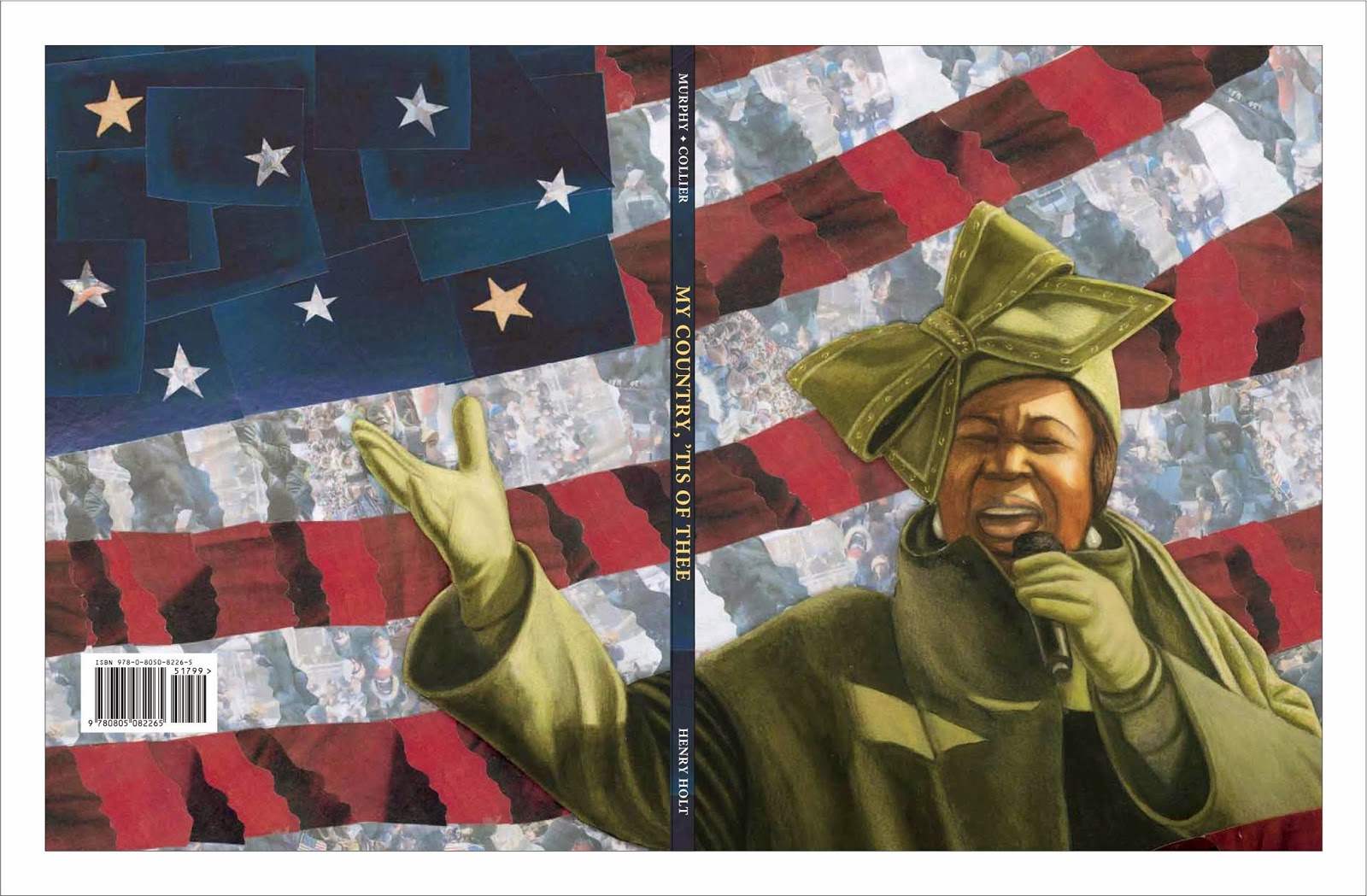
I knew immediately that all my years of research had brought me to this place where I could put this history together for young readers in a format that would connect with them in an inventive way because they already knew the melody. Everybody does. I knew immediately that I had finally discovered the structure I needed, possibly the best structure I’ve ever used in a nonfiction book. And it brought double pleasure because it also tied into my love of music. Because I had done all that research for so many years it allowed me to realize how this song truly did represent the history of civil rights in our country. I wouldn’t have realized how important these verses were if I didn’t already understand the power and depth and breadth of protest throughout our country’s two hundred plus years. Most of my research doesn’t appear in the book, but it holds up, gives gravitas to the verses I feature, even if the reader doesn’t fully understand it. They get it. And Bryan Collier’s stunning illustrations bring these protest verses to life in a new way, too, for readers to pore over.
I am delighted that I end the book with the line: “Now it’s your turn. Write a verse for a cause you believe in.” Because this invitation to young readers has become the focus of my promotion as I help launch this book. With the support of my publisher, I have started a contest, inviting students across the country to submit new verses. I have books and posters to send to the winners.
Second graders in Spokane wrote this verse:
Schools should be bully-free,
Full of our honesty,
Friends should be kind.
Include us in your game,
Please treat us all the same,
Stop calling us those names,
Friends should be kind.
A 5th/6th grade class wrote this one:
My country ‘tis of thee
So sad the poverty
Homeless abound
God keep them in your sight
Help us relieve their plight
Shelter them for the night
New hope is found
My hope is that teachers will grab onto this way to teach history and music and use it as a writing activity in class. New verses can be submitted on my web site and musical recordings of the verses can be found there too.
Let freedom ring!
Thanks so much, Claire, for writing this insightful and inspirational post for The Fourth Musketeer's readers.
Recommended for ages 8 to adult.
NOTE: A guest post from author Claire Rudolf Murphy will appear in this blog on Wednesday!Most of us don't really think much about the "patriotic" songs we are taught back in elementary school. Before reading this fascinating account, all I knew about the song "America," more commonly known by its first line "My Country, 'Tis of Thee," was that it was sung to the same tune as "God Save the Queen."
In a stunning new picture book by
Claire Rudolf Murphy, we are able to follow the history of this iconic American song, which has morphed over the years with new lyrics and versions sung in different times, as our country struggled with different issues of freedom and civil rights.
The book traces the song from its earliest version in 1740's England, when it was sung by supporters of the British monarch George II, to the inauguration of President Obama. Murphy paints the history of the United States in broad strokes; in an interesting layout choice, the information about the song is in a smaller font, while the outlines of the historical context, written in a terse one sentence format, are in a much larger, old-fashioned font that recalls the look of early printed books and newspapers. From a special version of the song for Washington's inauguration, to versions that call for liberty for women, slaves, and Native Americans, the song evolved to address the continual quest for freedom and justice in America.
The book is greatly enhanced by striking two-page illustrations from award-winning illustrator
Bryan Collier, featuring his signature style, a mix of vibrant watercolor and collage.
Extensive back matter includes the music and lyrics for the song America, source notes, a bibliography, and further resources, including musical links.
Inspired by the book, Murphy has created the
My Country Tis of Thee Music Project, which offers a play list with all the different versions of the song mentioned in the book. In addition, choirs "of all ages and abilities" are invited to upload their own versions of the song, including new lyrics.
With the advent of Common Core around the country, teachers, parents and librarians will be looking for more outstanding nonfiction books to integrate into the curriculum.
My Country 'Tis of Thee is an outstanding book to recommend to teachers and families, particularly of children in elementary school.
Recommended for ages 8-12
In this mash-up of fairy tale and historical fiction set in mid-19th century Norway, 14-year old Astri is sold by her aunt to a horrible (and lecherous) goat-herder to serve as his servant and more. Astri manages to not only escape but also rescue her younger sister, so that they can try to get to America, where her father has emigrated. With the goatman in pursuit, they must travel west of the moon, and east of the sun in this masterful story in which a 19th century immigrant's story is seamlessly mixed with Norwegian folklore and mythology. The novel features a terrific feisty, no-nonsense heroine very loosely based on the author's own ancestors.
Recommended for ages 8-12
This slim historical novel in verse packs an wallop of an emotional punch. It tells the story of Mina Tagawa, a young Japanese-American girl from Seattle who along with her family is imprisoned in an internment camp in Idaho, where they live for three years.
The author sensitively portrays this shameful period in our history, and the way in which different members of Mina's family react: her stoic grandfather; her angry father, a newspaper reporter who is arrested soon after Pearl Harbor; her frustrated teenaged brother, who joins the highly decorated Japanese regiment that fought in Europe. We also see the reaction of Mina's white best friend and her family, who try to remain loyal to their Japanese American friends and neighbors during this difficult time. In a particularly moving passage, Mina's brother Nick writes of his experience liberating Dachau, drawing comparisons to the camp he lived in Idaho surrounded by barbed wire and guard towers like the ones he saw in Germany.
In an afterword, the author explains that she was inspired to write Dust of Eden by her childhood doctor, a second-generation Japanese American who was interned along with his family during World War II. The afterword gives a short background on the chronology of the internment.
One of my favorite parts of my job as a children's librarian is being able to see all the new children's picture books that have been ordered as they come in. Here are some of my recent favorites:
A Lion in Paris, by Beatrice Alemagna (Tate, 2014).
In this enormous picture book, a young, curious, and bored lion wanders far from his savannah home to find a "job, love, and a future." Where else to go for these but Paris, where he is initially scared by the big city, but soon is enjoying a coffee at a famous Parisian cafe, riding the Metro, and visiting Parisian landmarks like the Louvre and the Eiffel Tower. Older children and adults are likely to appreciate the unusual and sophisticated artistic style of drawing mixed with collage but even young children can appreciate the "fish out of water" theme that recalls classic stories such as Babar and Curious George. Those who have visited Paris or dream of visiting Paris will particularly enjoy the artist's renditions of well-known Parisian sights.
Boa's Bad Birthday, by Jeanne Willis (Andersen Press Picture Books, 2014).
Every kid has experienced getting a present he can't stand and having to pretend that he likes it. Find out what happens when all of Boa's jungle friends bring him the worst presents ever in this hilarious new picture book. Whimsically illustrated by Tony Ross, this book offers perhaps the only boa constrictor you'll see in a birthday hat. This is a great storytime book for preschoolers and early elementary school students. The kids had a great time trying to figure out why each present that Boa gets was ridiculous for him! (i.e. mittens--no good because he has no hands...) Whimsical illustrations by Tony Ross add to the fun.
I am Cat, by Jackie Morris (Frances Lincoln Children's Books, 2013).
Cat lovers of all ages will delight in this magnificently illustrated ode to cats of all types. Through lyrical but brief text, a house cat dreams of her wild sisters, imagining herself a tiger, lion, cheetah, cougar, and other cats both rare and familiar. The book features gorgeous full-color two-page spreads. Back matter offers small illustrations and brief factual descriptions of the wild cats seen in the book for those who would like further information on these animals, most of which are endangered in the wild.
Recommended for ages 7-10.
My 18-year old son is an accomplished magician, and started to get into magic around the age of eight--and if you talk to professional magicians, you'll find most of them because interested in magic at around that age. Because of this, I am always intrigued by new children's books featuring kid magicians, particularly those featuring "regular kids", i.e. not of the Harry Potter variety.
The Vanishing Coin is the first volume of a promising new series for those just getting into chapter books (i.e. of the Magic Treehouse/Junie B. Jones difficulty level). This book features an awkward fourth grader named Mike, who seems to suffer from ADHD (but no talk about meds in this book). His parents have made him quit soccer so he can focus more on school work, but staying on task is an endless struggle for him. Is there anything that he's good at?
When he and his neighbor Nora (who's annoyingly good at everything) discover a dusty old magic store, complete with a colorful owner (shades of Bruce Coville's Magic Shop series), Mike feels an instant connection--and discovers that he's really good at magic tricks. Will this help him fit in in 4th grade and even deal with the school bully?
Because the book is co-written by a magician, Mike Lane, it includes directions to do actual magic tricks discussed in the book--i.e. the reader can learn tricks right along with Mike. This is very appealing for young readers--combining the best of a chapter book and a to-do-magic book. The book is abundantly illustrated with appealing cartoon-style drawings by illustrator Eric Wight, author and illustrator of the Frankie Pickle series. The first in a series, The Vanishing Coin should be appealing to both boys and girls, particularly those who identify with a character trying to find his place in the world and feel "special."
Volume 2, The Incredible Twisting Arm, is already available as well. I'd love to see a great website to go along with this series, featuring links to sites of appropriate magicians, magic tricks, magic history, etc.
View Next 25 Posts




























